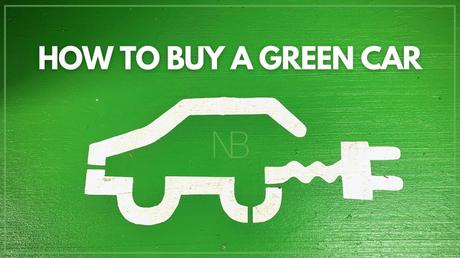
Cars are notoriously bad for the environment, but there are plenty of options out there to minimize your impact so you can make a responsible purchase.
Find our seven expert tips before buying your next green car and help the environment.
1. Buy a used car
Even if you're buying an efficient new vehicle with the latest fuel-saving technology, the amount of resources, energy and pollution involved with creating a vehicle will take years - if not decades - until the fuel savings make up for the initial environmental cost.
According to Scientific American, Toyota found that 28 percent of a car's CO 2 emissions come from the production and shipping of the vehicle to a dealership. [1]
Considering that many cars are shipped from across the world and require thousands of pounds of materials to produce, it starts to make sense. Plus, if more people purchased used cars instead of new ones, manufacturers would react to the demand and slow down production, significantly reducing the impact of producing thousands of cars a year. You can do your part in slowing down that demand by sticking to the used market.
So no matter what car you go with, used cars have a leg up environmentally over the latest tech.
2. Buy a newer model
Next, find something modern. As emission regulations tightened over the years, cars have been required to burn cleaner and cleaner. Chances are a newer car will be more fuel-efficient and (hopefully) was produced with more environmentally friendly production regulations in mind.
Yes, a 1997 Civic is still going to sip fuel compared to most cars today, but its emissions are going to contain substantially more pollution. To meet current regulations, cars are fitted with more restrictive exhausts. They have their engines designed with those stringent regulations in mind, significantly cutting back on their harmful fumes - all of which that Civic didn't need to do when it rolled off the production line 25 years ago.
Consider that every few years, the restrictions get tighter and you'll find that the newer a vehicle is, the less it will pollute.
But even with its dirtier emissions, it takes significantly less energy to move a Civic than some of the big vehicles on the road today.
3. Buy a smaller car
Large vehicles may have cleaner emissions compared to that 1997 Civic, but the sheer quantity of fuel they need to burn can offset any efficiency gains.
A smaller vehicle needs less gasoline to get up to speed, requires fewer raw materials to make, and is easier to ship from the factory.
However, even inefficient SUVs are still required to meet modern regulations.
Whether it's better to drive a modern SUV getting 15 MPG with the latest eco-friendly tech vs. that 1997 Civic hitting 40 MPG with an old exhaust is up for debate.
What isn't is that a small and efficient vehicle is the best of both worlds.
Some lifestyles require larger vehicles, but if your top priority is minimizing your carbon footprint, buy something smaller.
4. Buy an electric or hybrid car
To no one's surprise, in order of most to least C02 emissions, it goes: gasoline, hybrid and finally electric.
But depending on where you live, some energy is going to be cleaner than others. In many parts of the world, most of the electricity comes from coal, one of the dirtiest power sources.
However, even if your electric car is running off electricity from coal, it's still significantly more efficient than a gasoline car. While it's great if your power comes from sustainable sources, don't fret if you know coal will be charging your car each day.
If that still bothers you, some electricity providers will offer cleaner energy sources at a higher cost. If you want to minimize your environmental footprint as much as possible, ensuring your electric car runs on renewable resources is a necessity.
Unlike gas-only cars that can only get less efficient from the factory, electric cars are getting greener as those power grids use more renewable sources.
While electric cars certainly have some drawbacks, there are unexpected pros for buying a used electric car, showing they are often not just the green choice, but also the economical one.
If your lifestyle can't support an electric car, hybrids are an excellent choice for a flexible and efficient daily driver. Even with the extra parts required to build a hybrid, their gasoline-only siblings will eventually have more significant environmental impact if the hybrid is driven long enough to offset their more complicated production.
5. Buy a reliable car
Keeping your vehicle in good running order is important not just for your wallet, but also for the environment.
The fluids in your car are quite toxic. That is why it's essential to fix any leaks you see sooner than later (another point for electric cars, which have fewer fluids to leak).
If you are doing work that requires draining fluids from your car, ensure they are disposed of correctly. Many auto parts stores can properly dispose of these for you.
In the same thread, make sure your exhaust is in good shape. Catalytic converters do the heavy lifting when it comes to cleaning your emissions. They tend to last around 10 years or 100,000 miles [2]. If your car starts to smell like rotten eggs, has sluggish performance or gets excessively hot, those are all signs your catalytic converter might be bad.
Similarly, if your car has those symptoms and it has started to become louder for no reason, you might have an exhaust leak. It is exactly what it sounds like; part of your exhaust is not air-tight, and unfiltered emissions are leaving from a leak somewhere down the road.
This is another repair that should be handled immediately as all the restrictions to clean your exhaust as much as possible can go directly outside.
Burning oil emits particularly bad toxins into the air as well. So try to occasionally check your oil levels for healthy amounts of fluid and look for bluish smoke from your exhaust.
6. Keep your car for longer
Research shows that even with the higher production costs to produce hybrid and electric cars, they will eventually offset the C02 emissions produced to create the vehicle if they are driven long enough. [3]
So the longer you keep your vehicle on the road, the better.
7. Diesel vs. Gasoline - take your pick
While Volkswagen's emissions scandal has left a bad taste in the mouth for most environmentalists, diesel doesn't particularly pollute more or less compared to traditional gasoline cars.
In general, diesel engines produce more harmful emissions but are more efficient and use less fuel to output the same amount of power as gasoline. While gasoline engines burn cleaner, they need more fuel outputting more albeit cleaner, exhaust fumes.
While the numbers are close, diesel is still the dirtier choice - but not by much. Chances are a well-maintained diesel is going to run much cleaner than an older gasoline car burning oil with a clogged catalytic converter.
Conclusion
So in summary, the best green car you can buy for helping the environment is a used electric car with access to clean power sources. If you must get a gasoline car, grab a used, relatively modern hybrid in good condition and stay on top of its maintenance.
Unfortunately, a car is a necessity for many parts of the world, but just because they pollute doesn't mean we can't consider the environment with our purchase!
Sources
- When Used Cars Are More Ecofriendly Than New Cars, Scientific American
- How Long Does a Catalytic Converter Last?, Carparts
- Cleaner Cars from Cradle to Grave, UCUSA

